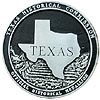| |
|
|
Historic Cattle Dipping Vat |
|
 |
|
Kingsville,
TX,
USA
Latitude & Longitude:
27° 33' 12.53417000004",
-97° 50' 13.03658999988"
|
| |
| |
|
Texas State
Historical Marker |
In 1894 this vat-- believed to be the first in the world-- was built to stop the spread of tick fever, which was destroying thousands of U.S. beef cattle. By the 1880s, the disease had become widespread, and official and shotgun quarantines prevented cattle from moving across the affected area, bounded by a line from the Rio Grande to the Atlantic. Although the mortality rate from tick fever (also called Texas and Splenetic fever) sometimes reached 90 percent, longhorns and other native southwestern cattle were immune. They did, however, carry the insect, which could infect other animals. Efforts to eradicate the tick (Margaropus annulatus) centered here, headed by officials from Texas A & M College and the U.S. Bureau of Animal Industry. Manager of the King Ranch, R. J. Kleberg, allowed the vat to be built, and 25,000 tick-infested cattle from the ranch were dipped. An effective formula of oil and sulphur was found here. In October, 1898, the U.S. quarantine was lifted for cattle treated in the dip. This eradication program not only introduced a new weapon for controlling cattle diseases, but also freed the industry from restrictive quarantines, thus increasing the value of cattle throughout the U.S. Recorded Texas Historic Landmark, 1967.
This page last updated: 7/15/2008 |
Historic Cattle Dipping Vat Historical Marker Location Map, Kingsville, Texas
|
|
|
|


